I have been upcycling feed bags into market totes, chicken
coop artwork, Christmas stockings and shipping envelopes for years and this spring I’m putting the feed bags to use in a different way: as portable potato gardens. Planting potatoes in a container allows them to be grown in a small space and provides more flexibility in location. It’s ideal for keeping my chickens from scratching them up and it frees up space in my garden for other plants and herbs they won’t eat. The technique is remarkably simple and I’m looking forward to the spuds in a
few months!
TATER TOTES: FEED BAG POTATO PATCH
SUPPLIES NEEDED
woven plastic Feed bag with top end cut off
Seed potatoes
garden soil/compost chicken manure compost or potato fertilizer
LET’S MAKE IT!
About the potatoes
I ordered Yukon Goldseed potatoes, but there are endless varieties from which to choose; I found this variety selector very helpful. Store bought potatoes are not as good a choice as specially grown, disease-free, seed potatoes.
When the potatoes arrive, they can be “chitted,” or sprouted to give them a head-start in the growing process. Placing them in a bright location for a week or two will result in eyes that sprout to an inch or less. I didn’t bother chitting mine because I’m impatient like that and they’ll grow fine without it.
Before planting, the sprouted potatoes can be cut into pieces, each containing a sprout, (or eye) but the cut pieces must be dried for 2-4 days before planting to avoid rotting. I used whole potatoes.
How to Plant ’em
Roll down a cuff on the feed bag 2/3 of the way down. I placed straw in the bottom for drainage.
Fill bottom 1/3 of the bag with high-quality compost/garden soil
Place 5 potatoes, eyes up, into the soil. They shouldn’t touch each other or the sides of the bag.
Either add a layer of chicken manure compost (my material of choice) or sprinkle some potato fertilizer around the spuds (not on top of them).
Cover with ~4 inches of compost/garden soil to the top of the bag.
Using a sharp knife or pair of scissors, poke holes in the bottom and sides of the bag for drainage.
Place in a location that receives full sun. Water sparingly each morning. The soil should not be soaked, but should not dry out either.
When leaves are approximately 6 inches tall, roll bag up a bit and cover all but the top most leaves with compost/garden soil. Repeat as leaves grow.
Fertilize every other week until leaves turn yellow and begin to dry out.
When leaves are dried out, harvest by cutting open the bag (preferably directly in the garden). Allow harvested potatoes to cure in full sun after harvesting for a day or two. The spuds will be ready to harvest in approximately 3 months (varies by variety).
Four months to the day, I dumped out the feed bags in my garden and found that the Yukon golds were a respectable size. While I put them in a basket, my chickens had a worm field day!
For other uses for empty feed bags, visit my blog article here.
This post was shared with: Adorned from Above, Blissful & Domestic, Cheerios & Lattes, Crafts a la Mode, Dear Creatives, Fluster Buster, Diana Rambles, Dude Sustainable, I Gotta Create,I Gotta Try That, Lavender Garden Cottage, The Prairie Homestead, Small Footprint Family, The Pin Junkie, The Wilderness Wife
Kathy Shea Mormino
Affectionately known internationally as The Chicken Chick®, Kathy Shea Mormino shares a fun-loving, informative style to raising backyard chickens. …Read on


shop my SPONSORS
I have been upcycling feed bags into market totes, chicken
coop artwork, Christmas stockings and shipping envelopes for years and this spring I’m putting the feed bags to use in a different way: as portable potato gardens. Planting potatoes in a container allows them to be grown in a small space and provides more flexibility in location. It’s ideal for keeping my chickens from scratching them up and it frees up space in my garden for other plants and herbs they won’t eat. The technique is remarkably simple and I’m looking forward to the spuds in a
few months!
TATER TOTES: FEED BAG POTATO PATCH
SUPPLIES NEEDED
woven plastic Feed bag with top end cut off
Seed potatoes
garden soil/compost chicken manure compost or potato fertilizer
LET’S MAKE IT!
About the potatoes
I ordered Yukon Goldseed potatoes, but there are endless varieties from which to choose; I found this variety selector very helpful. Store bought potatoes are not as good a choice as specially grown, disease-free, seed potatoes.
When the potatoes arrive, they can be “chitted,” or sprouted to give them a head-start in the growing process. Placing them in a bright location for a week or two will result in eyes that sprout to an inch or less. I didn’t bother chitting mine because I’m impatient like that and they’ll grow fine without it.
Before planting, the sprouted potatoes can be cut into pieces, each containing a sprout, (or eye) but the cut pieces must be dried for 2-4 days before planting to avoid rotting. I used whole potatoes.
How to Plant ’em
Roll down a cuff on the feed bag 2/3 of the way down. I placed straw in the bottom for drainage.
Fill bottom 1/3 of the bag with high-quality compost/garden soil
Place 5 potatoes, eyes up, into the soil. They shouldn’t touch each other or the sides of the bag.
Either add a layer of chicken manure compost (my material of choice) or sprinkle some potato fertilizer around the spuds (not on top of them).
Cover with ~4 inches of compost/garden soil to the top of the bag.
Using a sharp knife or pair of scissors, poke holes in the bottom and sides of the bag for drainage.
Place in a location that receives full sun. Water sparingly each morning. The soil should not be soaked, but should not dry out either.
When leaves are approximately 6 inches tall, roll bag up a bit and cover all but the top most leaves with compost/garden soil. Repeat as leaves grow.
Fertilize every other week until leaves turn yellow and begin to dry out.
When leaves are dried out, harvest by cutting open the bag (preferably directly in the garden). Allow harvested potatoes to cure in full sun after harvesting for a day or two. The spuds will be ready to harvest in approximately 3 months (varies by variety).
Four months to the day, I dumped out the feed bags in my garden and found that the Yukon golds were a respectable size. While I put them in a basket, my chickens had a worm field day!
For other uses for empty feed bags, visit my blog article here.
This post was shared with: Adorned from Above, Blissful & Domestic, Cheerios & Lattes, Crafts a la Mode, Dear Creatives, Fluster Buster, Diana Rambles, Dude Sustainable, I Gotta Create,I Gotta Try That, Lavender Garden Cottage, The Prairie Homestead, Small Footprint Family, The Pin Junkie, The Wilderness Wife



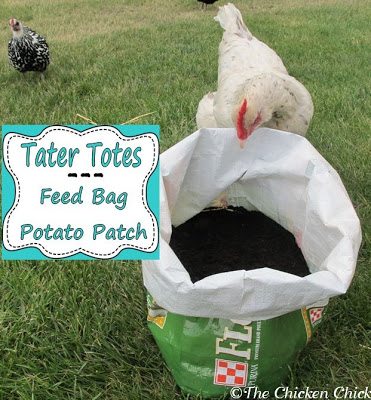
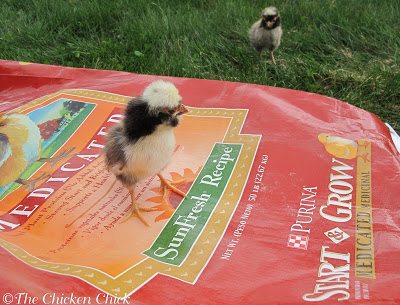







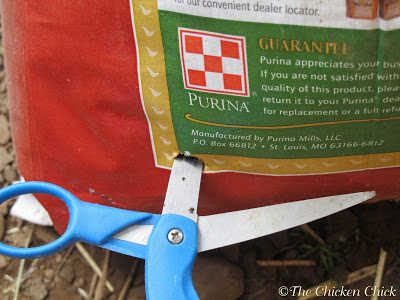
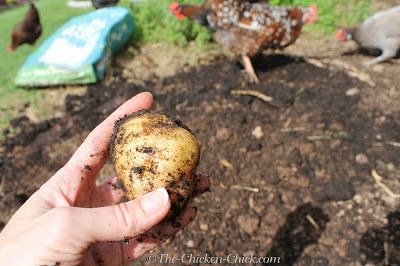
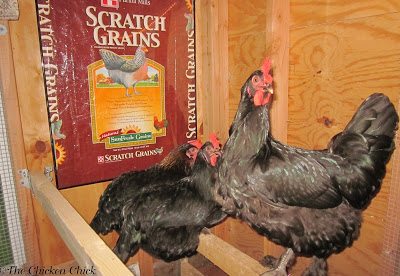























Thanks for visiting, Eric!
Love this idea!
This is such a great idea! I've seen them done in plastic garbage cans before, but never feed bags. Very Clever. Pinning!
Blessings,
Nici
I am visiting from the PIN Me linky party! I pinned your post to my gardening board. Great way to reuse thos big bags!
Great idea to use feed sacks. I grow potatoes in a tomato cage that is wrapped in burlap, and use straw for mounding. I may give the feed sack a try next year. Thanks!